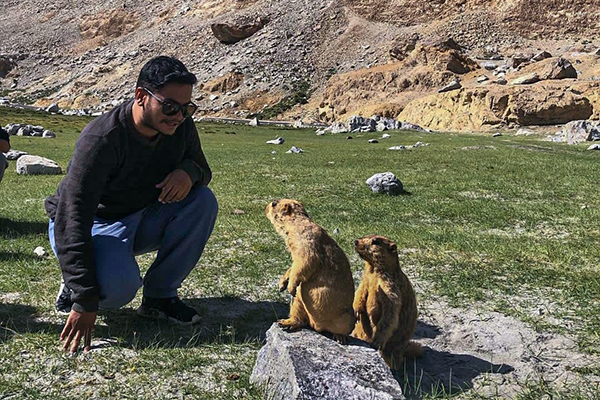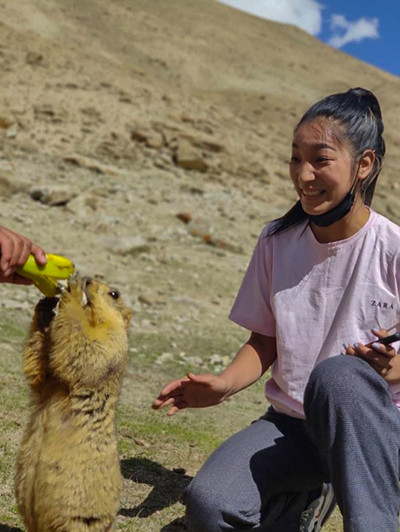Feeding marmots is a crime, ecologically harmful

Tourism is an important economic sector in Ladakh. The region was opened for tourism in 1974 and a record five lakh tourists have visited the region in 2022 so far. Many of these tourists are keen to visit the tourist sites such as Pangong-tso, which became famous as a location in the Hindi film, 3 Idiots.
While tourists take back a lot of good memories and photographs from Ladakh, one can ask what they leave back in Ladakh? The increase in tourism has resulted in multiple problems including plastic waste, loss of fragile habitats and disruption of the ecology of many wildlife species. Marmots are probably the best example of this damage, as they have become popular social media subjects for many tourists who visit Ladakh, especially Pangong-tso.
Marmots are generally shy by nature. They normally bask near their burrows in and around wetlands in higher altitude areas of Ladakh. These animals are regarded as being ‘cute’ and their calm nature has made them especially susceptible to negative impacts of tourism in areas where their habitats are close to popular routes such as the road to Pangong-tso.
Over the last few years, these wild rodents along the road to Pangong-tso have become so habituated to humans that they have lost their inherent fear, which makes them vulnerable to hunting. More importantly, tourists seem drawn to them and they have become a regular feature on social media posts. As a result, the marmot population along the road to Pangong-tso have acquired a taste for factory-processed food such as biscuits, potato chips, corn flakes etc. While this area is under the Changthang Wildlife Sanctuary, there is little to stop the tourists from feeding the marmots with processed food and handling them—the unnatural diet increases risks of lifestyle diseases among the marmots, while the constant handling makes them vulnerable to stress-related ailments and increases the risk of transmission of zoonotic diseases between humans and marmots. Unfortunately, the photographs on social media only fuel this behaviour further among other tourists.
In this regard, many local guides are part of the problem as many of them encourage this behaviour or even ‘bait’ the marmots for the enjoyment of their groups. There are several locals, including members of the tourist industry, who actively discourage tourists from this behaviour but this is a small minority. Furthermore, when we, along with several local Ladakhis, tried to highlight the negative impacts of this behaviour on social media, we ended up being trolled and abused!
We also noticed that several of the marmots in the area are starting to show signs of alopecia, which is related to hair loss, which can be fatal in the harsh climate of Ladakh. This is also a visible symptom of many underlying diseases. It is also possible that a diet of processed food with high quantity of sugar, salt and preservatives and changes in lifestyle are causing various health issues in this marmot population including high cholesterol though this has not been studied so far. In addition, this diet is also known to increase risks of genetic mutation. Studies suggest that these processed foods cause 30% humans to suffer from cardiovascular diseases, 50% increase in risk of diabetes and increased risk of various forms of cancer. In addition, micro-plastics in the environment are causing various forms of unpredictable genetic changes in various species.

In the wild, marmots consume seeds, flowers and grasses. The marmots and other wild species already face various challenges from road building projects, increased population of stray dogs and habitat loss. Marmots are also known to be hunted for their skin and meat. In addition to these challenges, the irresponsible behaviour of tourists and the lack of regulation have magnified the threats faced by the marmots along the road to Pangong-tso. This is probably causing poisoning, congenital diseases, teratogenicity and potential loss of this population of marmots. This is the price paid by wild marmots to satisfy social media fanatics.
The problem needs to be addressed urgently. There is a need to educate taxi drivers, tourist guides and travel agencies, who can explain to their groups why this behaviour is harmful to the marmots. In addition, some form of regulation, patrolling and strict collection of fines is required in this area, to stop tourists from harming these marmot populations. Perhaps the Department of Wildlife Protection can install a manned check post in this area to deter such behaviour. In addition, local conservation-related NGOs might be able to help support these efforts by spreading awareness and highlighting violations. Security agencies such as Indian Army and Indo-Tibetan Border Police can also be a part of this process as they are present in these areas. However, they can only assist efforts initiated by civilian agencies and cannot be expected to take responsibility for preventing such actions. In addition to such measures on the ground, it is also important to counter the narrative on social media with awareness posts about the ecological impacts and legal clauses related to such irresponsible behaviour.
When asked about it, Principal Chief Conservator of Forest, Ladakh, Jigmet Takpa, IFS said that this is a growing problem and that the Department of Wildlife Protection will take strict action against such offenders and those that facilitate it. He added, “This is unnatural and very harmful for the marmot population, which is included in Schedule II of Wildlife (Protection) Act, 1972, which means they enjoy the second highest level of protection under Indian laws. It also puts both humans and marmots at risk for transmission of various zoonotic diseases. In fact, this is a direct violation of Article 32 of Wildlife (Protection), Act, 1972 (ban on use of injurious substances) and offenders can be punished under Section 50 (power of entry, search, arrest and detention), Section 51 (fines), and Section 52 (attempts and abetment). We will use these provisions of the Wildlife (Protection) Act, 1972, to punish offenders as well as guides, taxi drivers and anyone who witnesses, facilitate and enable such activities. In addition, such people will also be banned from entering any protected area in Ladakh henceforth.”
By Dr. Abhinava Mukherjee and Dimpi A. Patel
Dr. Abhinava Mukherjee lives in Bardhaman, West Bengal. He is a dentist by profession and passionate about wildlife conservation and documentation.
Dimpi A. Patel is an independent wildlife researcher and illustrator. She is currently studying the ecology of herpetofauna in Ladakh.
